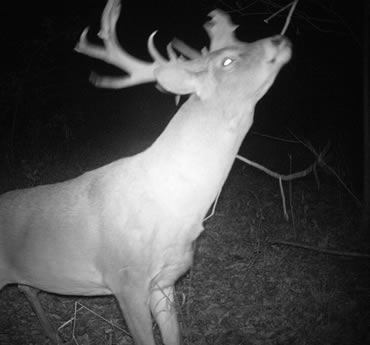Would you work the late shift for just one buck?
I was running late on the last day of bow season before the Illinois shotgun opener. To add insult to injury, I knew I was going to miss the last and best few hours of the day since I had to be back to work at 4 that evening.
On the bright side, the bucks had been pushing does pretty hard. I had seen quite a few deer, but no big bucks, although I had caught a few bruisers on trail cameras.
Around 8:45, as I drove to my hunting area, I noticed a buck bedded up along the ridge that runs parallel with the road and overlooks a bean field. I didn’t get a good look, and there was no way to sneak up on him without getting busted.
I thought it over and decided the traffic and road activity would most likely push him to the west. I decided to sneak out and take up a stand in a draw about 300 yards in that direction.
I got to the stand around 9:15 and got ready to spend the day. By noon, the only thing I had seen were a few does crossing the bean field a couple of hundred yards away.
Not long after, a set of twin fawns meandered to within 10 feet and bedded down. I opted to wait them out instead of scaring them off. By the time they moved on, it was close to 2:30.
I was considering climbing down and heading back to where I had seen the buck on the ridge when I heard movement in the timber to the west.
Four does came into view, tails up and eyes looking back. Behind them was a buck.
I got my first good look at him as he crossed the creek and headed up the bank in my direction. He was wide and tall, but I didn’t have any idea about points. I lost sight of him as he chased a doe less than 50 yards away.
The other does were milling around and watching the buck from less than 40 yards. I took the opportunity to nock an arrow and get ready.
The wait was painful, and I had to remind myself to keep breathing. He was a very respectable non-typical. In 35 years of hunting with a bow, I had never taken a non-typical buck.
He finally pushed the doe back toward my stand. She joined the other does at just under 30 yards, and the buck stopped right behind her, his head concealed by a tree.
It was a perfect opportunity to draw my bow, but one of the does must have seen the movement, because she snorted.
I kept my cool, took careful aim and let the arrow fly. Already alert, the deer rocketed out of there, heading back to the creek bed and out of sight.
Short on time, I got down in hope of finding a bloody arrow. There was no arrow and very little blood where he had been standing at the shot.
 I crept toward the creek bed to where the does had disappeared and still found nothing. I was crushed. Had I just blown an easy opportunity at a buck of a lifetime?
I crept toward the creek bed to where the does had disappeared and still found nothing. I was crushed. Had I just blown an easy opportunity at a buck of a lifetime?
Considering my options, I realized it would be best if I quietly backed out and headed to work. It was the longest shift I have ever endured. The buck was all I could think about, and I replayed the shot in my head a thousand times.
I returned to the woods the next morning, and it didn’t take long to find my prize.
When the deer hit the creek bed, the does had gone west, while the buck turned and went east. I found him under a large tree that had fallen across the creek just 60 yards from where I shot him.
He’s a 23-pointer with drop tines, palmation and triple brow tines on both sides. He’s massive and well balanced, with a 216 7/8 BTR score.
There were a lot of things working against me that wonderful day, but it shows what can happen when you hunt a good area, do your homework and have faith.
Read Recent Articles:
• Scaling New Heights: How treestand height affects impact points and shot angles.
• Big Deuce: Two brothers, two arrows and one very big buck.
• Big Deuce: Two brothers, two arrows and one very big buck.
This article was published in the October 2013 edition of Buckmasters Whitetail Magazine. Subscribe today to have Buckmasters delivered to your home.